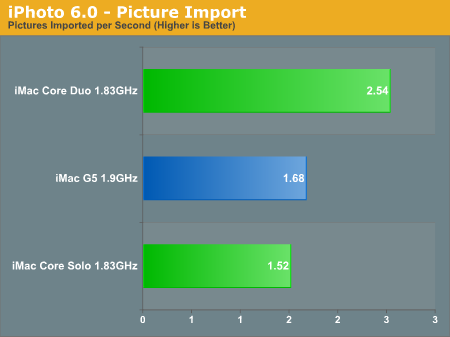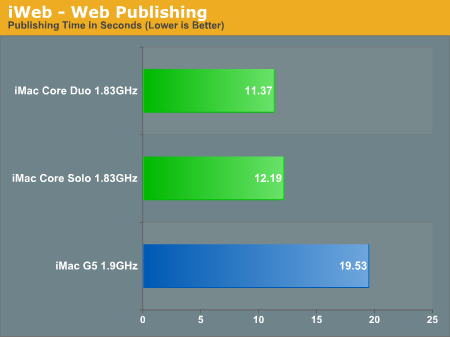Apple Makes the Switch: iMac G5 vs. iMac Core Duo
by Anand Lal Shimpi on January 30, 2006 11:26 PM EST- Posted in
- Mac
iLife '06 Performance with iPhoto, iDVD and iWeb
With iPhoto, Apple has really created an excellent digital photo album application that is extremely robust. Steve Jobs is always demonstrating how iPhoto can handle tens of thousands of pictures without a problem, but given that I am testing iMacs with 512MB of memory, I'll stick to our paltry 379 photos as the data for this next test.
The test is simple; I timed the import of all 379 photos into iPhoto which, believe it or not, is quite CPU intensive and not as I/O bound as you'd think. After I attained the time, I divided it into 379 to get the number of pictures imported per second. Like many operations in OS X, the iPhoto import process is multi-threaded, giving the Core Duo an inherent advantage over the G5. So, I've included Core Solo performance in the chart below as well:
Next up is iDVD, an application that you can use to create DVDs that are playable on any consumer DVD player. There are, once again, two aspects to performance in iDVD: video encoding performance and menu encoding performance. Since we've already looked at video encoding performance with Quicktime, this test is predominantly limited by how long it takes to encode the menu system in my test DVD. There is a small 13-second iSight video and audio that's encoded in the process, but it adds a matter of seconds to the overall time. The image is written to disc instead of sent to the DVD burner for obvious reasons. The results are expressed in seconds, lower being better. And once again, we are dealing with a multi-threaded workload, so both the Core Duo and Core Solo are present in the chart:
A newcomer to Apple's iLife suite is iWeb, a web publishing application. I haven't had much time to play with the application, but I did use it as a benchmark - measuring the time that it took to publish a site with a handful of pages, 10 blog entries and 10 podcast entries. This test was mostly single-threaded, although there were a few moments where the second core did get some action, so I included both the Core Duo and Solo:
With iPhoto, Apple has really created an excellent digital photo album application that is extremely robust. Steve Jobs is always demonstrating how iPhoto can handle tens of thousands of pictures without a problem, but given that I am testing iMacs with 512MB of memory, I'll stick to our paltry 379 photos as the data for this next test.
The test is simple; I timed the import of all 379 photos into iPhoto which, believe it or not, is quite CPU intensive and not as I/O bound as you'd think. After I attained the time, I divided it into 379 to get the number of pictures imported per second. Like many operations in OS X, the iPhoto import process is multi-threaded, giving the Core Duo an inherent advantage over the G5. So, I've included Core Solo performance in the chart below as well:

Next up is iDVD, an application that you can use to create DVDs that are playable on any consumer DVD player. There are, once again, two aspects to performance in iDVD: video encoding performance and menu encoding performance. Since we've already looked at video encoding performance with Quicktime, this test is predominantly limited by how long it takes to encode the menu system in my test DVD. There is a small 13-second iSight video and audio that's encoded in the process, but it adds a matter of seconds to the overall time. The image is written to disc instead of sent to the DVD burner for obvious reasons. The results are expressed in seconds, lower being better. And once again, we are dealing with a multi-threaded workload, so both the Core Duo and Core Solo are present in the chart:

A newcomer to Apple's iLife suite is iWeb, a web publishing application. I haven't had much time to play with the application, but I did use it as a benchmark - measuring the time that it took to publish a site with a handful of pages, 10 blog entries and 10 podcast entries. This test was mostly single-threaded, although there were a few moments where the second core did get some action, so I included both the Core Duo and Solo:











35 Comments
View All Comments
Illissius - Tuesday, January 31, 2006 - link
Compared to native applications, obviously, it's less than ideal; on the other hand, compared to, say, PearPC, it's pretty amazing. (I don't have any data and haven't tried it myself, but from what I've heard I'd suspect it runs at 5%-ish performance; compared to that, 30-70% is a minor miracle.)I know it won't interest the end user any whether it could've been even worse, but wanted to point it out, nonetheless ;).
yacoub - Tuesday, January 31, 2006 - link
I wonder how it compares in game- oh, right, Mac. Hehehe ;)DrZoidberg - Tuesday, January 31, 2006 - link
there is one very popular game on mac.World of warcraft....could anandtech pls include a benchie comparing mac with intel core duo vs g5 in wow? It would be interesting to see if apple switching to intel means macs are better at games (or not).
fitten - Tuesday, January 31, 2006 - link
Is the Universal Binary out for WoW yet?Cusqueno - Tuesday, January 31, 2006 - link
I have a 20" iMac Core Duo and with the default 512 RAM it was bad performance. About 5-10 fps in IronForge and 20-25 elsewhere. When I upgraded to 2 GB RAM it has improved greatly, maybe 10 - 20 in IF and 30 - 40 on the road. I guess this is due to Rosetta using lots of RAM.As of last night, there was no Universal binary. But today is patch/reboot day so might be pushed when I get off work. It is supposed to be included with version 1.9.3 according to the WoW forums.
fitten - Thursday, February 2, 2006 - link
That's pretty awesome considering that you're running WoW in emulation (Rosetta).vortmax - Tuesday, January 31, 2006 - link
Seeing that Rosetta is needed for all MS and Adobe apps. and since using Rosetta seems to take lots of memory, it would be nice to see how it runs with 1gb. Also, some benchmarks from Photoshop would be nice :)Thanks Anand!
Lifted - Tuesday, January 31, 2006 - link
"... but those are the ones we want to measure anyways so they have to be there."Eug - Tuesday, January 31, 2006 - link
Does turning off one core turn off half the cache?ie. Is it really Yonah Core Solo, or is it Yonah Celeron M?
maconlysource - Wednesday, February 1, 2006 - link
Where did you get the toolbar single proc- dual proc utility.I installed the developer pkg on my Intel iMac but can't find it?
Can you email me it?
Thanks.
Pete.